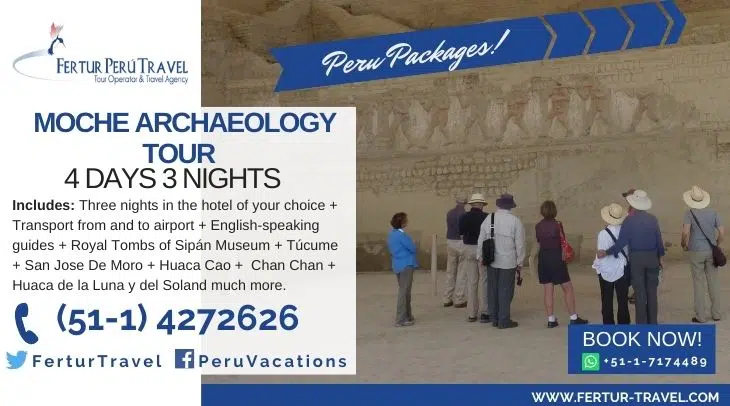
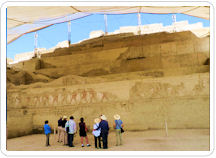
For nearly 500 years, they dominated Peru’s northern coast, before entering a 2½-century period of climate catastrophes and societal decline. Book now your Moche Archaeological Tour with Fertur!
This four-day journey is designed to relate the world’s most dramatic story of climate change in the ancient world, as told through an archaeological retrospective of this magnificent, and ultimately self-destructive and doomed society.
The Moche were among the most accomplished ceramic workers in the world, meticulously documenting in highly realistic fired-clay artifacts their culture, population, religion, architecture and agriculture, their wars, ceremonies and burials, their medicine, arts and sexuality.
Prices available upon request

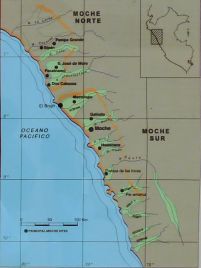
For nearly 500 years, the Moche culture dominated more than 300 miles of Peru’s northern coast, extending inland from the Pacific Ocean to the high western slopes of the Andes.
A rigidly stratified society ruled by a caste of warrior-priests, the Moche used a complex system of irrigation canals to cultivate vast yields of sweet potatoes, corn, lima beans, peanuts, quinoa and squash.
Moche were among the most accomplished ceramic workers in the world, meticulously documenting in highly realistic fired-clay artifacts their culture, population, religion, architecture and agriculture, their wars, ceremonies and burials, their medicine, arts and sexuality.
The Moche also stood out among ancient Peruvian societies for their practice of publicly celebrating ritual battle and a ceremony of blood sacrifice of the vanquished.
Blood was the main currency of Moche political and ideological belief. It was the highest symbol of regeneration and integration between the people and their gods.
The ritual sequence of the armed encounters were graphically narrated by Moche artists, who inscribed the powerful images upon ceramics and modeled clay, to instruct the masses and reveal to them the sacred codex of the warrior disciple.
The prevailing scientific theory now holds that the frightful scenes depicted in Moche art are faithful representations of actual behavior, and possibly even records of specific events.
Archaeologists believe the tombs of the Moche lords and high priests excavated in the last quarter century correspond directly to the religious characters depicted in their exquisite pottery and in the extensive mural reliefs on the walls of their temples.
Controlling a dozen fertile river valleys from about 100 C.E. (Common Era), Moche society maintained this religious ideology, but things began to fall apart around 600 C.E. when they were hit by a string of catastrophic climate events: El Niño-driven floods and gigantic mudslides followed by intense droughts.
The people lost faith in their rulers, and by 850 C.E., their civilization was gone, dead and buried, and eventually replaced by a new empire, the Chimú.
This four-day journey is designed to tell the world’s most dramatic story of climate change in the ancient world.
Hotels
Chiclayo: Costa del Sol ⭐⭐⭐⭐
Trujillo: Libertador ⭐⭐⭐⭐
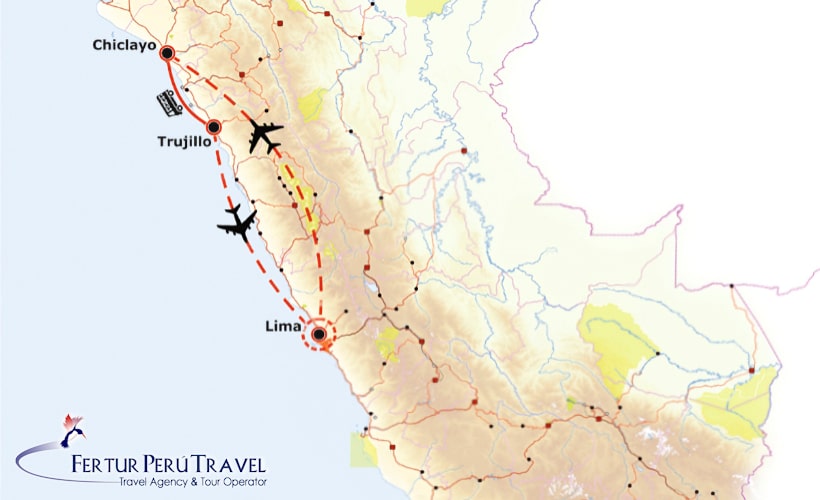
Pickup and transfer from airport or bus station for transfer and checkin at your hotel (Costa del Sol).
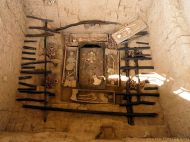
Early morning pick-up from your hotel and start your full-day private excursion to the Huaca Rajada and its excellent site museum.
The mud-brick burial platform here was where archaeologist Walter Alva made his world famous 1987 discovery of the tomb of the Lord of Sipán, the first of several major finds at the site. Carbon-dating shows the Moche lord died around 290 C.E.
He was interred with his royal entourage, and several sacrifices, as well as a treasure trove of ceremonial regalia and priceless relics: pectoral shields made of shell, bone and stone, blankets adorned with ornate, gilded, copper platelets, necklaces of very fine metalwork, feather ornaments, headdresses and three sets of ear plugs inlaid with turquoise.
Also buried with him were ceremonial utensils such as tropical Spondylus and Conus sea shells, silver and gold rattles, knives, golden death-masks, and a copper scepter topped with a complex architectural model held in his right hand.
The tomb was widely considered the most important archaeological find in half a century and was compared to the discovery of the tomb of Tutankhamen in Egypt.
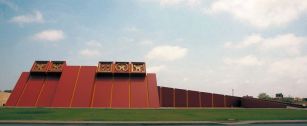
Transfer to Lambayeque for a guided tour of the Royal Tombs of Sipán Museum, the ultra-modern, three-story exhibition dedicated exclusively to the stunning contents of the Lord of Sipán tomb, and the tombs of a dozen other individuals excavated at the site.
This innovative museum is designed as a dark red pyramid that visitors enter from the top. Descending through the galleries, you encounter the objects in the same sequence as the archeologists during their years of excavations.
Lunch at the award winning El Cántaro Restaurant, Lambayeque.
Then visit Túcume, which to the untrained eye might appear at first glance more like a group of highly eroded foothills than what they are, an unprecedented concentration of massive ancient pyramids.
The late Norwegian archaeologist and explorer Thor Heyerdahl, of “Kontiki” fame, put the site into perspective in 1990 when he remarked: “When I came across the forest of isolated carob trees that hides the view of the ruins, I thought I was dreaming. I had never seen anything like this. The largest complex of monumental structures of adobe in the New World; 26 large pyramids and many other smaller ones, contained in a sacred place that covers 500 acres.”
The Lambayeque culture, which flourished around 700 C.E., built more than 250 solid adobe pyramids, one of the highest concentrations of pyramid structures known in the world, located in a single valley.
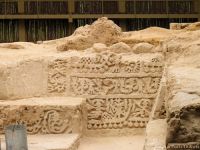
Discoveries of the remnants of royal courts, kitchens and workshops atop the pyramids helped Heyerdahl’s colleagues — archaeologists Daniel Sandwiess and Eduardo Narvaéz — to conclude the elite of this mysterious society were the residents of palaces built high above the valley floor.
They, as the Moche before them, and the Inca hundreds of years later, believed that the great mountains were deities with the power to control nature. The archaeologists theorized that these ancient people — similar to the Moche — built the giant pyramids to emulate the magic power of the mountain Gods in a futile attempt to control nature and stave off prolonged periods of catastrophic climate change.
Most of the archaeological excavations at Túcume remain closed to the public. But recently on the southwestern edge of the pyramid valley, researchers have opened Huaca de las Balsas, an amazing excavated site that forms part of a small complex of truncated pyramids that carbon date to around 1100 C.E. Its dramatic mud relief murals reveal a Moche-inspired cosmovision of the inhabitants.
The excavated fireplaces, kitchen, food remnants and human and animal remains offer a glimpse into their domestic lifestyle.
Return to hotel in Chiclayo. (B/L)

Setting out early for Trujillo, your first stop is at San José de Moro, an important excavation site where in 1991 archaeologists Christopher Donnan and Luis Jaime Castillo unearthed the “Sacerdotisa” — a high level Moche priestess.
Here you will have the chance to stretch your legs, use the rest room, and most importantly, meet master Moche artisan Julio Ibarrola and the local children who, in his workshop, learn the ancient techniques to create Moche ceramic art.
The program is supported by the Sustainable Preservation Initiative to help local communities earn money through ecotourism, and to keep the Moche artistic tradition alive.
The pieces are so realistic that if they were not embossed on the bottom with the children’s signatures, buyers of the ceramics would run the risk of having the pieces seized at the airport by wary officials on the lookout for smuggled black market antiquities.
Continuing your journey, the next stop is the archaeological complex “El Brujo” situated about five kilometers south of the Chicama River, above an elevated plain and adjacent to the Pacific Ocean.
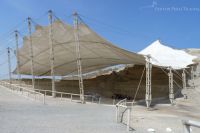
The denomination “El Brujo” (or “The Witch Doctor”) is owed to the fact that for hundreds of years at this site, healing masters of the area congregated to perform “mesados,” or shamanic rituals.
The first thing you notice as you approach the complex is that the desert floor is pock-marked by thousands of holes, like a moonscape, left behind by “huaqueros” (tomb raiders).
Girded by bright green sugar cane fields, the archaeological complex is vast, encompassing a cultural sequence of 5,000 years: From Huaca Prieta (2500 B.C.E.), Cupisnique (1,000 B.C.E.), Salinar and Gallinazo (100 B.C.E.) Mochica (100-800 C.E.), Lambayeque (900-1,100 C.E.) Chimú (1,300 C.E.) and Colonial (1,570-1,750 C.E.).

Of these sites, the Huaca Cao Viejo, and its adjacent Cao Museum, is the centerpiece and main focus of your tour.
Recent excavations of what was once a huge pyramid temple revealed rooms and terraces decorated with exquisite, colorful wall art — typical Moche religious motifs of ritual sacrifices and supernatural deities.
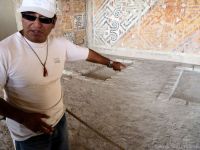
In 2005, archaeologist Régulo Franco — led, he says, by a shamanic dream scape vision of a young female puma — discovered the intact tomb of the Lady Cao, a young woman adorned with the regalia of a high Moche religious and political leader.
Her arms were decorated with tattoos of snakes and spiders, indicating she was imbued by her people with mystical powers. This woman, who died around 300 C.E., shortly after giving birth, is believed to have been the first known female ruler of pre-Columbian Peru — a Cleopatra of South America.
Lunch restaurant overlooking the ocean front village of Huanchaco, where you can enjoy excellent Peruvian seafood and northern cuisine while you watch surfers and the local fishermen on their traditional “Caballitos de Totora” or reed boats, riding the waves.
Transfer to your hotel (Hotel El Libertador). (B/L)
After a leisurely morning, you set out for a private city tour of Trujillo, including the main attractions of the Spanish colonial center, followed by a tour of the Arco Iris Temple of the Chimú Culture, and the archeological complex of Chan Chan, the world’s largest adobe mud brick city.
After lunch at a traditional restaurant in the city, you make the 20 minute drive to the ancient city of Moche and the Huaca de la Luna.
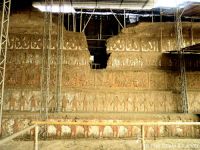
A few miles south of the modern city of Trujillo, the city of Moche. At its height, the city covered an area of about a quarter mile, separating two monumental structures: Huaca del Sol (Temple of the Sun) to the west and Huaca de la Luna (Temple of the Moon) to the east at the foot of Cerro Blanco, or “White Mountain,” considered a deity by the Moche people.
It was the pioneering work of German archaeologist Max Uhle in 1899 that initiated studies of the complex, one of Peru’s most important ancient sites. Studies resumed in 1991 and showed that the Moche city’s inhabitants transformed the desert into fertile farmlands by a complex and extensive irrigation system. The Moche also exploited the river, forest, lomas (fog meadows) and maritime habitat, to produce a surplus of food.
Huaca del Sol apparently served as a political and administrative center (excavations currently taking place to test that theory).
Huaca de la Luna, at the other end of the city, comprised the paramount temple and leading political and ceremonial center of Moche society.
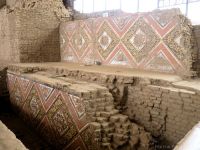
What the Moche left behind in the Huaca de la Luna is remarkable: Extensive, painstaking excavation at Huaca de la Luna in recent years offers the most expansive view of Moche culture.
The archaeological evidence points to a desperate reaction of the Moche’s religious leadership to appease the Gods in the face of extreme climate change that devastated their world.
Huge mural reliefs and pottery show naked captives tied together with ropes around the neck; prisoners ritually beheaded, defleshed, and dismembered; female victims tied to stakes and left to birds that peck at their eyes and genitals.
Hundreds of dismembered victims were found encased in mud. The sacrifices correspond to a series of El Niño events that wiped out Moche irrigation and blanketed their farm lands, followed by prolonged, severe draughts starting in about 600 C.E.
Then visit the newly opened Museum of Moche Temples to view the best ceramics of the Moche culture, and to gain greater insight into the significance of the Temples of the Sun and the Moon.
To end your journey, you will visit two local artisan workshops. In one of them, you can participate in the production of handcrafted replicas of Moche ceramics.
These artisans have revived the ancient manufacturing techniques of the famous “Moche figurines” using the same style of clay molds utilized 1,400 years ago. In addition we will visit an expert leather crafter.
Transfer to the hotel and the airport. (B/L)
(B) Breakfast, (L) Lunch, (D) Dinner
The program includes:
Not Included:
< Prev: Inca Inspiration 11 Days
To book your Peru packages now or consult with us, fill out the “Contact Us” form to the right and a Fertur Peru Travel coordinator will contact you within one working day with detailed information about your fully customizable trip. Fertur Peru Travel’s pledge is to offer you top-quality, individualized attention that starts with the planning of your trip and continues through your journey to guarantee a great vacation.
Go Back to Chiclayo Tours